50 I Believe Essay Topics
To better train students on how to present their personal opinions on subjective matters, teachers will assign what is known as an “I Believe” or “This I Believe” essay writing assignment.
Designed to provide the reader with insight into the writer’s character, these essays are typically written in first-person point of view. The writer shares their beliefs on a particular topic – ranging from religion and politics to more personal subjects such as love and happiness – and offers supporting arguments for why they hold these beliefs.

The Challenges of Writing “I Believe” Essays
This type of essay prompt is a welcome break from more detail-oriented or researched-based writing assignments for many students. However, “I believe” essay writing assignments aren’t always easy.
It can be challenging for students to articulate their beliefs in a clear and concise way that isn’t argumentative or offensive to the reader. Students may also struggle to explain their reasoning behind these beliefs in a thorough and not overly simplistic way.
Despite these challenges, “I believe” essays can be an excellent opportunity for students to share their thoughts and feelings on important topics and learn more about themselves in the process.
Tips for Writing “I Believe” Essays
If you’re given an “I believe” essay assignment, here are a few tips to help you get started:
- Start by defining what it is that you believe. This may seem like a simple task, but it can be challenging to identify your core beliefs. If you’re struggling, start by jotting down a list of topics that are important to you – from politics and religion to family and friendship.
- Reflect on why each topic is important to you. Think about the reasoning behind your choices and how these reasons evolved over time. After all, your core beliefs are likely to have changed or grown since you reached adolescence.
- Determine which of your beliefs are the most important. Focusing on developing thought processes that support your beliefs. For extra help, consider sharing these thoughts with a trusted friend or family member for advice.
By reflecting upon your core beliefs and developing clear arguments to support them, you can craft a powerful “I believe” essay that will truly reflect your thoughts and feelings.
How to Write an “I Believe” Essay
To craft a well-written “I Believe” essay, students must forgo the typical essay structure of introduction, body, and conclusion.
Instead, the essay should be organized around a series of specific beliefs that the writer wishes to share. Each thought should be introduced with a clear thesis statement, followed by supporting arguments and examples.
The conclusion of the essay should wrap up the main points that have been made and leave the reader with a final thought to ponder.
Here is an example of how an “I Believe” essay might be structured:
Thesis: I believe that everyone has the right to love and be loved.
Argument: Everyone deserves to find love and experience happiness in their lives. This should not be limited by race, religion, socioeconomic status, or any other factor.
Example: I saw a video of a man proposing to his girlfriend at Fenway Park. She said yes and the crowd went wild! Now that is love. If they can find it, then so can we all!
Conclusion: Society should not stand in the way of love. Love is the most powerful force in the world, and we should all embrace it.
As you can see, the “I Believe” essay structure allows for a great deal of flexibility. Students can choose to focus on a variety of topics and can organize their essays in different ways. An “I Believe” essay can be an excellent opportunity for students to present their thoughts on important issues under a few simple guidelines. With a bit of planning and organization, this type of essay writing assignment can be a breeze!
What You Shouldn’t Do When Writing an “I Believe” Essay
To ensure that you are writing an “I Believe” essay and not another form of an argumentative or persuasive essay, avoid doing the following:
- Don’t provide evidence or use statistics to support your position – this is not an essay that calls for research.
- Don’t attack or criticize the beliefs of others – your goal is to share your own opinions, not to tear down those of others.
- Don’t go off on tangents – stay focused on the main points you want to make.
- Don’t speak objectively or in the third person – for example, don’t say “people believe that” or “studies show.”
- Don’t use filler words and phrases such as “I think,” “I feel,” and “it seems like.”
Use any of these 50 “I Believe” essay topics to help you brainstorm ideas for your essay!
I Believe Essay Topics About Life
- I believe that life is too short to spend time with people who bring you down.
- I believe that laughter is the best medicine
- I believe that we should make time for quiet reflection every day.
- I believe that the only thing that matters in life is love.
- I believe that we are all capable of change.
- I believe that it is never too late to learn and grow.
- I believe in the power of positive thinking.
- I believe that we should always be kind, even when it is difficult.
- I believe that there is no such thing as a coincidence.
- I believe in the saying “what goes around, comes around.”
- I believe that we are all responsible for our own happiness.
- I believe that the best things in life are free.
- I believe that it is essential to be grateful for what we have.
- I believe that it is never too late to achieve our dreams.
- I believe that we should surround ourselves with people who make us better.
- I believe that you can either love or hate something; there is no in-between.
I Believe Essay Topics About Education & School
- I believe that education is the key to a bright future
- I believe that children are our future and should be treasured as such.
- I believe that there is no such thing as a dumb question.
- I believe that schools should do more to celebrate diversity.
- I believe that homework is essential, but it should not be excessive.
- I believe in the importance of having a strong support system while attending school.
- I believe that standardized tests are not an accurate measure of a student’s knowledge.
- I believe that it is vital to find a balance between work and play while in school.
- I believe that everyone should have the opportunity to learn how to swim.
- I believe in the importance of recess and physical activity in students’ lives.
- I believe that there is no such thing as a bad grade.
- I believe that teachers deserve more respect and better pay.
- I believe that it is never too early to learn a foreign language.
- I believe that education should be free for everyone.
I Believe Essay Topics About Friends & Family
- I believe that family is the most important thing in life.
- I believe that friends are the family we choose for ourselves.
- I believe that it is essential to maintain close relationships with friends and family.
- I believe that there is no substitute for quality time spent with loved ones.
- I believe that family is not defined by blood but by love and commitment.
- I believe that we should spend more time with the people we care about and less time worrying about material things.
- I believe that it is better to have a few close friends than many superficial ones.
- I believe that it is healthy for friends to grow apart.
- I believe that competition between friends is healthy.
I Believe Essay Topics About Money
- I believe that money cannot buy happiness.
- I believe that it is essential to be happy with what you have, not what you want.
- I believe that people are more important than things.
- I believe that it is okay to splurge on something even if it means going into debt.
- I believe that it is better to give than to receive.
- I believe that money can’t buy everything.
- I believe that the love of money is the root of all evil.
- I believe in saving for a rainy day.
- I believe in investing in oneself.
- I believe in the saying, “money doesn’t grow on trees.”
- I believe that rich people should be forced to pay more taxes.
These 50 I Believe essay topics are sure to inspire your own original beliefs and help you create a powerful and unique essay. When writing your I Believe essay, be sure to focus on the beliefs that are most important to you and that you feel passionate about discussing. The best I Believe essays are the ones that are personal and reflective, so don’t be afraid to share your own thoughts and experiences.
Related Posts
- 140 Definition Essay Topics
- 200 Persuasive Essay Topics
- 170 Comparative Essay Topics
- 130 Narrative Essay Topics
- 100 Mental Health Essay Topics
Categories:
- Essay Samples
- Essay Topics
- Essay Writing Guides
Recent posts:
- 170 Ethics Essay Topics
- 160 Satire Essay Topics
- 160 Rhetorical Essay Topics
- 155 Criminal Justice Essay Topics
- 150 Political Essay Topics
- 145 Classification Essay Topics
- 140 Sociology Essay Topics
- 140 Opinion Essay Topics
- 140 Environmental Essay Topics
- 135 Controversial Essay Topics
- 125 Classification and Division Essay Topics
- 120 Literary Essay Topics
- 100 Profile Essay Topics
- 90 Heart of Darkness Essay Topics
- 80 Holocaust Essay Topics
Testimonials


Want to create or adapt books like this? Learn more about how Pressbooks supports open publishing practices.
32 “This I Believe” Essay
The history of ‘this i believe’.
by Tanya Matthews
This I Believe is an exciting media project that invites individuals from all walks of life to write about and discuss the core beliefs that guide their daily lives. They share these statements in weekly broadcasts on NPR’s Morning Edition and All Things Considered .
The series is based on the 1950’s radio program This I Believe , hosted by acclaimed journalist Edward R. Murrow. Each day, some 39-million Americans gathered by their radios to hear compelling essays from the likes of Eleanor Roosevelt, Jackie Robinson, Helen Keller and Harry Truman as well as corporate leaders, cab drivers, scientists and secretaries — anyone able to distill into a few minutes the guiding principles by which they lived. Their words brought comfort and inspiration to a country worried about the Cold War, McCarthyism and racial division.
Eventually, the radio series became a cultural phenomenon. Eighty-five leading newspapers printed a weekly column based on This I Believe . A collection of essays published in 1952 sold 300,000 copies — second only to the Bible that year. The series was translated and broadcast around the globe on the Voice of America. A book of essays translated into Arabic sold 30,000 copies in just three days.
[The NPR series This I Believe can be read and heard here . In addition, the website and organization This I Believe houses thousands of essays written by famous people, such as the ones mentioned above, and everyday people like you and me.]
As a college student in 2020, you are faced with turbulent politics, socioeconomic issues, and ethical dilemmas that will challenge you to take a stand and contribute to the local, national, and global conversation around you. The purpose of this writing task is not to persuade you to agree on the same beliefs. Rather, it is to encourage you to begin the much more difficult task of developing respect for beliefs different from your own. Fifty years ago, Edward R. Murrow’s project struck such a chord with millions of Americans. It can do so again today…with you.
Video Resources for Generating Ideas
Dan gediman on writing a “this i believe essay”.
Read Cecelia Munoz’s essay “Getting Angry Can Be a Good Thing” referred to in the previous video here .
“This I Believe” Essay with Animation
“This I Believe” Essay Ideas
Prewriting Activity
1) analyze others’ statements.
Consider the following statements, written in response to the question What Have You Learned About Life? Highlight any sentences that resonate with you. Talk about them with a partner or group, explaining why. 1. I’ve learned that when I wave to people in the country, they stop what they are doing and wave back. – Age 9 2. I’ve learned that if you want to cheer yourself up, you should try cheering someone else up. – Age 14 3. I’ve learned that although it’s hard to admit it, I’m secretly glad my parents are strict with me. – Age 15 4. I’ve learned that if someone says something unkind about me, I must live so that no one will believe it. – Age 39 5. I’ve learned that there are people who love you dearly but just don’t know how to show it. – Age 42 6. I’ve learned that you can make someone’s day by simply sending them a little note. – Age 44 7. I’ve learned that the greater a person’s sense of guilt, the greater his or her need to cast blame on others. – Age 46 8. I’ve learned that no matter what happens, or how bad it seems today, life does go on, and it will be better tomorrow. – Age 48 9. I’ve learned that regardless of your relationship with your parents, you miss them terribly after they die. – Age 53 10. I’ve learned that making a living is not the same thing as making a life. – Age 58 11. I’ve learned that life sometimes gives you a second chance. – Age 62 12. I’ve learned that whenever I decide something with kindness, I usually make the right decision. – Age 66 13. I’ve learned that it pays to believe in miracles. And to tell the truth, I’ve seen several. – Age 75 14. I’ve learned that even when I have pains, I don’t have to be one. – Age 82 15. I’ve learned that every day you should reach out and touch someone. People love that human touch—holding hands, a warm hug, or just a friendly pat on the back. – Age 85 16. I’ve learned that I still have a lot to learn. – Age 92
2) Compose Your Own Statement
Write down a sentence that expresses what YOU have learned about life. Maybe it is similar to one of the statements above; maybe it’s completely different. Whatever it is, write it down.
3) Freewrit e
Now free-write about your sentence. Include at least two examples / experiences that you have had that support why you think this way.
Personal Statement/Philosophy: ______________________________________________________________________________________________________________________________________________________ Why do you believe in this statement? ______________________________________________________________________________________________________________________________________________________ Name two experiences that you had that would support the statement: _______________________________________________________________________________________________________________________________________________________________________________________________________________________________________________________________________________________________________________________________________________________________________________________ What does this say about yourself or your personality? _________________________________________________________________________________________________________________________________________________________________________________________________________________________________ After your life experience, how have you come to the conclusion that this should be your statement? How have your beliefs changed, if at all? ____________________________________________________________________________________________________________________________________________________________________________________________________________________________________________________________________________________________________________ How has the event effected your relationship with a person, place, or object? _________________________________________________________________________________________________________________________________________________________________________________________________________________________________ How does your statement apply to you today? (How you view yourself & society) ______________________________________________________________________________________________________________________________________________________
SAMPLE STUDENT ESSAYS
Sample #1: america’s beauty is in its diversity.
written by Alaa El-Saad, high school student, as heard on NPR’s Tell Me More (2009)
America is built on the idea of freedom, and there is no exception for Muslim women. I believe in the freedom of religion and speech. But mostly, I believe it’s OK to be different, and to stand up for who and what you are. So I believe in wearing the hijab.
The hijab is a religious head covering, like a scarf. I am Muslim and keeping my head covered is a sign of maturity and respect toward my religion and to Allah’s will. To be honest, I also like to wear it to be different. I don’t usually like to do what everyone else is doing. I want to be an individual, not just part of the crowd. But when I first wore it, I was also afraid of the reaction that I’d get at school.
I decided on my own that sixth grade was the time I should start wearing the hijab. I was scared about what the kids would say or even do to me. I thought they might make fun of me, or even be scared of me and pull off my headscarf. Kids at that age usually like to be all the same, and there’s little or no acceptance for being different.
On the first day of school, I put all those negative thoughts behind my back and walked in with my head held high. I was holding my breath a little, but inside I was also proud to be a Muslim, proud to be wearing the hijab, proud to be different.
I was wrong about everything I thought the kids would say or even do to me. I actually met a lot of people because of wearing my head covering. Most of the kids would come and ask me questions—respectfully—about the hijab, and why I wore it.
I did hear some kid was making fun of me, but there was one girl—she wasn’t even in my class, we never really talked much—and she stood up for me, and I wasn’t even there! I made a lot of new friends that year, friends that I still have until this very day, five years later.
Yes, I’m different, but everyone is different here, in one way or another. This is the beauty of America. I believe in what America is built on: all different religions, races and beliefs. Different everything.
Sample #2: The Essentials to Happiness
written by Alexxandra Schuman, high school student, as heard on The Bob Edwards Show (2013)
As a child, I was generally happy; singing and dancing to my favorite songs; smiling and laughing with my friends and family. But as far back as second grade, I noticed a “darkness,” about me. I didn’t enjoy engaging in many things. I didn’t relate to my peers in elementary school because they appeared so happy, and I didn’t have that ability to achieve happiness so easily.
In middle school things in my life began to get even worse. I began withdrawing from everything I once enjoyed; swimming, tennis, family. I hated going to sleep knowing I had to wake up to another day. I was always tired. Everything was horrible. Finally, midway through eighth grade, I was told I had a chemical imbalance; diagnosed with clinical depression and put on medication. It took months for me to feel the effects of the medication.
When I began to feel happy again, is when I realized that I had to take the responsibility for getting better myself, rather than relying on medication and therapy alone. Aristotle said, “To live happily is an inward power of the soul,” and I believe that this quote describes what I had to do to achieve happiness. Happiness is a journey. Everyone seems to need different things to be happy. But I believe people are blinded from what truly makes one happy.
Growing up, we’re encouraged to be successful in life; but how is success defined? Success and happiness are imagined now as having a lot of money. It is so untrue. Recently I went to Costa Rica and visited the small town of El Roble. I spent the day with a nine-year old girl named Marilyn. She took me to her house to meet her parents. It was obvious that they were not rich; living in a small house with seven children. The house was cluttered but full of life. Those who have decided that success and happiness comes from having money and a big house would be appalled at how utterly happy this family from El Roble is. People say that seeing things like that make you appreciate what you have, but for me, it made me envy them for being so happy without all the things I have.
“The essentials to happiness are something to love, something to do, and something to hope for,” a quote from William Blake sums up what I believe people need to realize to be truly happy in life. People need love; I feel they need their family and their friends more than anything in the world. People need work to do, something to make them feel they are making a difference in the world. People need to know that more good is to come in the future, so they continue to live for “now” instead of constantly worrying about the bad that could come. And most importantly people need to know that happiness is not something that happens overnight. Love and hope is happiness.
Sample #3: Find a Good Frog
written by Delia Motavalli, high school student, as heard on The Bob Edwards Show (2013)
I believe in finding a good frog. It seems that all throughout childhood, we are taught to look for a happily ever after. “And they all lived happily ever after”; isn’t that the conclusion to many children’s films? When I was a kid I always thought of that as magical; but now really it just seems unrealistic. And it teaches us that what we want is a fairytale like they have in the storybooks. We all want to be Cinderella who gets swept off her feet by the hot prince; we want to live in the royal castle, right? But I don’t think that’s necessarily a good thing for us to seek. Now I’m not saying I believe in being pessimistic, but I do believe in being realistic; it’s something I got from my mom.
My mother and I always have our best conversations in the rain. We sit in the car, neither of us wanting to brave the rain to get to the house. So we sit. We watch droplets race down the windshield, listen to the rain strike the roof of her little blue Honda, and feel the heater on full-blast rushing at our feet (just the way we like it). I don’t know why, but sitting in the car, we always talk more than normal. There was one rainy day when my mom told me something that is going to stick with me forever. Earlier that day she and my dad had been arguing about something; I can’t remember what. So she said, “Don’t spend your life looking for Prince Charming. Instead, find yourself a really good frog.”
At the time, I found this thought really disheartening. Who wants to think that you’ll never find Prince Charming? You’ll never get to be Cinderella? Another thought that struck my mind: if my mom says there’s no Prince Charming, then what’s my dad? A frog? I asked her, and she replied with, “Of course! If he were Prince Charming, he wouldn’t snore, would be able to cook, and we would never argue. But you know what? He’s a damn good frog.” Of course, being young, I didn’t think of the meaning behind what she was saying. I was too busy thinking of it literally, visualizing my mom as a princess and my dad in frog form.
But a few years later, I understand the value of my mom’s words. You can’t expect everything to be perfect. Let’s be completely honest; if you wait your whole life for your prince with flowing hair, statuesque features, and a white horse, you’re going to be lonely. I think that the point of finding a good frog is you accept something that’s great, flaws and all. It’s so easy to be picky. You can find the one tiny thing that’s wrong, and that one tiny thing is what you can’t get your mind off of. But in life, we can’t afford to wait years in vain for perfection. So I think that a good frog, an amazing frog, the best frog you can find is what we’re really looking for in this world. Don’t laze through life waiting for a happily ever after, because I don’t think you’ll be very happy with the outcome.
Examples from the ‘This I Believe’ Website
Be Cool to the Pizza Dude by Sarah Adams
They Lived Their Faith by Charles Henry Parrish
Returning to What’s Natural by Amelia Baxter-Stoltzfus
The Birthright of Human Dignity by Will Thomas
Remembering All The Boys by Elvia Bautista
I Am Still The Greatest by Muhammad Ali
A Goal Of Service To Humankind by Anthony Fauci
My Life Is Better by Abraham
Give Me a Waffle by Brenda
The Little Things by Sophie Crossley
You can also browse thousands more This I Believe essays by theme .
Prefer to Listen to Get Inspiration?
Check out This I Believe’s Podcast Series
4) Drafting
Assignment guidelines + suggestions and tips for drafting.
1. While the examples you’ve been given can serve as a model, it is essential that each of you write about a personal belief or philosophy that you feel strongly about. 2. Tell a story. Personal experiences are the corner stone of a good essay. Your story doesn’t have to be a heart breaker or even a major event, but it must be something that has affected how you think, feel, and act. List your personal experiences that you intend to use as evidence below: 3. Be concise. Avoid repetition. This essay should be between 500 – 650 words. When read aloud, it should take roughly four minutes. 4. Name your belief. It is essential that you can name your belief in a sentence or two. Focus on one belief only. This is your thesis. Write it here: 5. Be positive. Avoid preaching or persuading. You aren’t trying to change the way others think or act. Write about what you believe, not what you don’t believe. 6. Use the first person. Speak for yourself. Avoid using we or you. 7. Let your voice shine. Use language that sounds like you. Read it aloud as your revise. Keep making changes until your essay sounds like you and captures the essence of your belief.
5) Peer Review
Once you have written your first draft, arrange for your essay to be edited by a peer, using the following Peer-Editing Checklist: Writer’s Name: ________________________________________________ Peer Editor’s Name: ________________________________________________ Use your PENCIL or PEN (NOT red or green) to make corrections. Remember, this essay is a work in progress. You are not done writing! Look for ways to improve what you’ve already written. Tick each step if it has been completed. _____ 1. Read the paper backwards, one sentence at a time. Check for spelling errors. Use a dictionary, a friend, or a spell checker to find the correct spelling. _____ 2. Check for capitalized proper nouns and the first word of each sentence. _____ 3. Skip a line between each paragraph. _____ 4. Every sentence should have end punctuation. _____ 5. Check commas. Are they only used for compound sentences, a list of items, an introductory word or phrase, direct address, setting off interruptions, separating adjectives, or in dates? Do you need to add commas? Make sure you do not have commas separating complete sentences (i.e. comma splice errors that create run-on sentences). _____ 6. Apostrophes are used only for contractions and to show ownership. _____ 7. The use of more complex punctuation (dashes, hyphens, semi-colons, parentheses, etc.) is done correctly. _____ 8. Have you used commonly mixed pairs of words correctly? Check these: they’re/their/there, your/you’re, it’s/its, a/an, to/too/two, are/our/hour, and others. _____ 9. Read the paper backwards one sentence at a time. Check for sentence fragments and run-ons and correct them. _____ 10. Did you stay in present tense (such as is, am, do, take, know, etc.) or past tense (such as was, were, did, took, knew, etc.) throughout the entire essay? _____ 11. Did you stay in first person (I, me, my, we, us, our) or third person (he, him, she, her, they, them, their) throughout the entire essay? _____ 12. Was there adequate use of specific details and sensory details? Were the details clear and relevant to the statement? _____ 13. Is the overall purpose/philosophy clear? _____ 14. Does the conclusion make you go, “Wow!” “Cool!” “I never thought about it that way,” or any other similar reaction? Other suggestions for the overall content of the piece: ____________________________________________________________________________________________________________________________________________________________________________________________________________________________________________________________________________________________________________
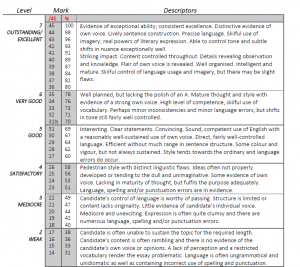
This I Believe by Tanya Matthews is licensed by CC-BY-SA
“This I Believe” Essay Copyright © 2020 by Liza Long; Amy Minervini; and Joel Gladd is licensed under a Creative Commons Attribution-ShareAlike 4.0 International License , except where otherwise noted.
Share This Book
Power Lesson: “This I Believe” Essays
December 4, 2016
Can't find what you are looking for? Contact Us
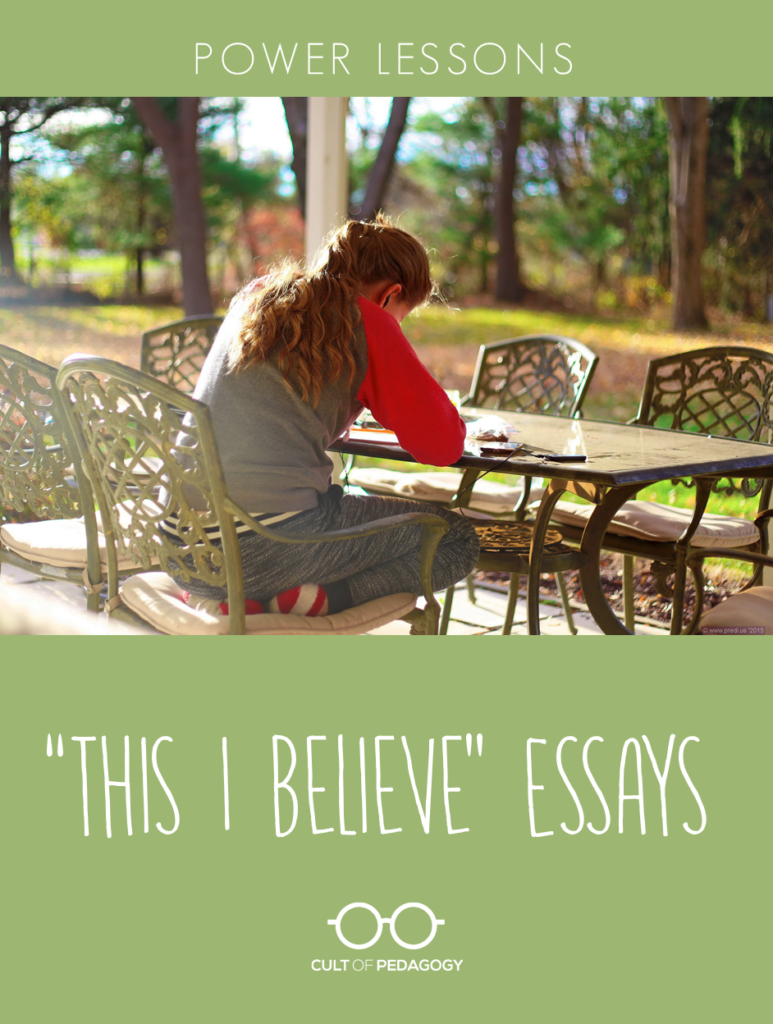
“Doing homework” by Predi is licensed under CC BY-ND 2.0
In this power lesson shared by high school English teacher Cynthia Ruiz , students write their own personal statements of belief. The essay pushes students to write about something that matters to them and helps them get to know each other on a deeper level.
I used to assign a “Letter to the Teacher” at the beginning of every year to get a snapshot of how a student writes while simultaneously learning background information. Being completely honest, this assignment is also an easy way to get the first few back-to-school days started when a 90-minute class period feels like 900 minutes, because everyone is typically on their best behavior and not talking much. Although I enjoy reading the letters, the assignment doesn’t lend itself to revising and is written only for a specific, one-person audience.
I know building relationships with students is important and a way to get to know them is through their writing, so I did some research to see what other teachers were trying. I came across the “This I Believe” site and immediately liked the concept better than an introduction letter for a teacher.
Assignment Guidelines
The first time I assigned a “This I Believe” essay was in the fall of 2014, during the second week of school. I planned it as a year-long endeavor, something we could work on as a distraction from other essays required to prepare for state testing. This past year, I did not assign it until late April; it would be our last major writing task. I wanted to give everyone plenty of time to write but held them to a firm deadline of having four weeks to work.
This time, I crafted my writing guidelines according to those posted on the NPR site that hosts hundreds of This I Believe essays from around the world. My rubric still has some typical writing conventions, but overall I think it focuses more on student voice than structure. I made it clear that students had a lot of choice regarding both content and format. The biggest restriction came directly from the This I Believe site: a 500-600 word limit. I know a lot of writing teachers are divided when it comes to word count, but I figured it was still better than giving a specific number of required paragraphs and sentences.
One other requirement was that students use at least three “vocabulary devices.” This may seem like a restriction, but it actually supported student voice. Over the spring semester, we spent a lot of time reviewing both rhetorical and literary devices (anaphora, hypothetical questions, simile) and I told students to focus on the devices they genuinely felt comfortable using.
Helping Students Choose a Topic
Because the rubric leaves room for a lot of choice, I encouraged students to visit the featured essays site and not only read, but listen to real examples. I wanted them to see that this wasn’t just another run-of-the-mill assignment, that what they believe is important and writing is just one way to share those beliefs. I also made it a point to tell them our end goal was to share this essay with their entire class by way of a gallery walk.
After giving students time to explore the site, I had them “rush write” in their notebooks to see what immediate ideas they captured to help start the brainstorming process. Here’s the prompt I used:
This I Believe For 2 minutes: List words or ideas that you think about when you think of YOUR LIFE. (Can be feelings, symbols, names, events, etc.)
After students generated this list, I asked them to consider what they wanted to write about and share with others. I wanted them to imagine a larger audience and think outside of meeting my expectations.
For some, deciding what to write about was easy and they began drafting immediately. However, the majority of students struggled not so much with what they believe, but how to write about it. Even though they appreciated having so much choice, they still needed some direction to get started.
We continued the listing strategy by focusing on “most memorables”: most memorable events in life so far, most memorable stuffed animal, most memorable friends, family experiences, life lessons learned, and so on. I asked them to focus on why they remember what they remember, and whether or not it impacts any of their beliefs. One student remembered a saying his grandmother always told him that still provides comfort as he’s gotten older. Another focused on her family not having a big house when they first moved to America and how she’s learned to be satisfied with opportunities instead of possessions. While this strategy helped a lot of light bulbs go off, it didn’t work for everyone.
Another strategy I tried was using involved sentence stems: I know I am the way I am today because______. I know I think about things the way I do because _______. I think most people would describe me as ______. I emphasized that these phrases did not have to be included in their final products, but should help generate ideas. I talked with a few frustrated students about this strategy and they told me it made them realize they’ve never really had to think about themselves in this way, but ultimately, it gave them direction for their essays.
Drafting and Revising
Because of block scheduling, I gave students about a week and a half to complete a working draft, which required having at least two paragraphs of their essay done. I only gave a portion of two to three class periods to actually write in class; students were expected to write on their own time.
On the day drafts were due, I set aside class time for revision. I asked students to refer to the rubric and focus on voice and vocabulary strategies. Questions I told them to consider were: Does this sound like me? Do I talk like this to my friends or family? I gave students the option of reviewing their own essays or partnering up with someone to peer edit. Again, this was the end of the year, so we had already established a pretty firm community of trust in class. I don’t know if peer editing would have been as easy had I done the assignment early in the year.
Overall, draft day didn’t feel like the usual “revising and editing” days we’ve had with other essays. Students were very concerned with whether or not they were making sense, if they should add more, or if they were being too repetitive, rather than only being concerned about capitalization, spelling, and grammatical errors.
Sharing the Finished Essays
The culmination of this assignment was when the essays were shared in a gallery walk . The gallery walk is my answer to having students write for a larger audience, and it really helps this essay become about what students have to say instead of just another grade. I can’t count how many times I have returned tediously graded essays only to have a kid immediately walk over to the recycling bin and trash it! Sure he read the comments and suggestions I made, or saw the cute smiley face I left by an excellent word choice, but it didn’t mean much to him because the paper is graded and finished, and he is now done thinking about it. With a gallery walk, not only are students thinking about what they wrote, but they have the opportunity to think about what their classmates wrote as well.
I printed each essay without any names, and made sure any identifying statements were revised. However, there were quite a few students who said they were proud of what they wrote and had no problem if others knew which essay belonged to them. Because not every student turned in a final copy, I printed additional copies of some completed essays to ensure every student had something to read during our gallery walk, instead of drawing attention to the two or three students who did not finish the assignment.
I placed the essays on different tables throughout the room and allowed students to move around as needed; some chose to stand and read an essay, others opted to sit, while others sprawled out on the floor to read. I played soft music and asked that the room volume stay quiet enough to be able to hear the music at all times. I didn’t mind if students were sharing and discussing, and I really wish I recorded the various conversations and comments I overheard that day: “Wow! Did you read this one yet?” “Man. Who wrote this? I might cry. Good tears, though.” “This one is life, Ms. Ruiz.”
I provided a pad of post-its near each essay and told students to leave POSITIVE feedback for each other. I provided sentence stems to help:
Something I liked…
Something I can relate to/agree with…
Something that surprised me…
Something I want to know more about…
I really think…
I periodically checked to make sure no one was being inappropriately critical or just leaving cute hearts or check marks. I wanted students to think about what they were reading, and understand that feedback is a crucial part of the writing process
After about 40 minutes, each essay had received multiple written comments, looking similar to the picture below:
Overall, the feedback was uplifting and actually created a sense of belonging in each class. Students told me they learned so much about each other that day and were shocked by their classmates’ writing. A few said they wished they had written this essay sooner.
Sample Student Work
I was floored by some of the essays I received. Some made me laugh, some made me gasp, some made me cry. Compared to the typical papers I usually assign, this essay allowed my students to not just think about what they were writing but to care about their writing and to be intentional in the language they were using, both in word choice and rhetorical strategies, because it was about what they believe. It is some of the strongest student writing I have ever received as an English teacher.
Here are some sample paragraphs from students who gave me permission to share their work:
From a student who told me he hates school and hates writing.
From a student who by all outward appearances, comes from a traditional family.
From a student battling depression and anxiety.
From a student who missed almost a whole semester but is trying to stay in school.
Although this essay helped end the year with a strong sense of community, I think teachers could easily have students write it at the beginning of the school year or even in January at the start of a new year. I’d love to hear how other teachers have used an essay like this in their classes. ♦
Have you taught a lesson or designed a learning experience we should feature in Power Lessons? Send a full description of your lesson through our contact form and we’ll check it out!
What to Read Next

Categories: Instruction
Tags: English language arts , lesson planning , power lessons
39 Comments
Cynthia and Jennifer, Thank you for sharing this Power Lesson; it’s one I plan on “borrowing” for sure in January. I love the connection built during the gallery walk. I can imagine this being truly powerful for all students. Well done!
I LOVE this!! I will use this in the Spring with my students. The excerpts in the blog post were so personal. I hope the students realize what a gift they shared.
Tonya, I agree. I’m always so grateful when students are willing to let us see their work here!
I love this assignment. I use it every semester with Public Speaking students, following a similar brainstorm and drafting process. Since the assignment comes from a radio program, my students audio record themselves, and our celebration of the work happens through hearing each student read the essay. Very powerful hearing their voices!
Ruth, thanks so much for taking the time to share this idea. I’m sure lots of teachers will love how audio enriches this assignment.
Thank you for sharing the students’ samples. Writing is such a great way to express oneself and when you make it personal students are engaged. ❤️ it! I am thinking about adding it as my last assignment for my 3rd graders!
Thank you for sharing, especially the students’ work samples.This will help inspire my students to share important details about their lives. Might I also recommend an excellent book I purchased used recently: Reading, Writing and Rising Up (by Linda Christensen)
I like this writing strategy. Last week I started something similar with my Arabic students. In groups of 3 to 4 students, they wrote stories (Brainstorm, first draft…) They started writing their final draft(with illustrations and drawings) on the butcher paper. On Monday, they will hang it on the wall and they will give each other feed back wile walking and reading each other’s essays. The problem with the foreign languages students writing is that they have brilliant ideas in English, but they cannot express them in Arabic or French… My questions is the following: Is there a way to adapt this writing strategy to World Languages students with taking into consideration the limited students’ language levels.
I love this assignment. I use at the end of the year with my seniors. I tell them to focus on a belief that they have formed over their past years of school and that will guide them as they make steps on their next journey — college, military, work, etc. Every year I am awed by the thought and pride they take in it. Their voices shine through the papers. The emotions, ranging from joy to sadness or humor to regret, overtake their essay making each both personal and universal. I also always write one that I individualize for each class and how they have shaped or firmed one of my own beliefs.
I love this, especially as a way to “re-enter” in January! I hope that I can use it effectively with my middle schoolers. Thank you so much for sharing this!
YES!! This was my first lesson in my first year of teaching and it completely set the tone for the rest of the year. The work I received from eleven year olds blew my mind, and I even submitted(with their permission) a few pieces to be published because they were that deep. Bravo to this I believe essays & sharing lessons like this with other educators.
Did you find that you had to add in any scaffolds/support for students? I want to try this with my 7th graders who really struggle with writing and getting started with ideas.
This looks like a fabulous project and one I am keen to try out next semester.
I, too, have been doing this assignment for a few years now. It is my favorite assignment of the year. I teach 8th grade English and I have my students share their essays aloud. We sit in a circle and listen to each student share his/her belief. It is powerful. We laugh. We cry. We learn. Having students write for an audience of their peers is challenging for them, but so rewarding in the end.
This looks great for January. I noticed that the This I Believe website has a high school curriculum for sale for $20. Has anyone used it? Is it worth it? Necessary?
This reminds me of an assignment I had in high school. It was called our “Capstone,” and was a year-long process (12th grade). We first chose three things that were important to our lives: a person, a place, and an event. Over the first semester we wrote about these in three separate papers. Then come second semester we had to connect them with a metaphor, and put together a 20 minute presentation that connected everything. It really allowed students to get creative while expressing what was most important to us.
Do you happen to have an example of this still? It sounds AWESOME and I would love to do it with my 8th graders!
Your students’ essays are beautiful, authentic and inspiring, as I am sure your teaching is. Thank you for sharing.
Thanks for the lesson. I like this idea for journaling too!
A brilliant idea! Thanks!
Thanks for sharing and including student work examples. Essays like this are a great way to get to know students at a deeper level and could also make a good college entrance essay!
Thank you for sharing this. Inspirational and heartfelt writing from young people.
This is so inspiring and beautiful. Thank you so much, both of you for sharing this power lesson. I was lookibng for a writing task muy ss could include in their e-Portafolio. Can’t wait to try it!! Thank you again!!
I know this might be simplistic, but could you share more about the vocabulary devices?
Hi, April! For the vocabulary devices, I’m referring to adding similes, metaphors, hyperboles, imagery, etc. We usually practice devices like anaphora and asyndeton in my advanced classes, so those can also be used. One of my favorite lines this year was: “I mean, I thought a step stool would do the job but instead it was like climbing a 20 foot ladder just to finish my goal…” We talked about how using a vocab device is more powerful than “I worked really hard.” Hope that helps! Cheers!
This is sooooo great!! I love it!!!!!
I love this. Has anyone tried it at the start if the year? Are students willing to write about such personal experiences and beliefs with a teacher and classmates that they don’t know well?
Hi Lizzie! I work for Cult of Pedagogy, but I’m replying as a teacher. I teach college level freshman comp and I started my previous semester with this essay. Because it was the beginning of the year, I didn’t do a gallery walk; it was more of a practice assignment to get used to the flow of papers and feedback. They had to bring in a rough draft for in-class workshops, so I made sure they knew a few of their classmates would be reading what they wrote. For extra credit, I offered them the chance to record their paper as a “podcast” and post it on YouTube. I was blown away by how in-depth most of them went! In fact, I’m starting my fall semester with it again.
I love this assignment in the spring for senior English. Generally, kids are appreciative that we’re doing the final writing assignment about something that is ‘real world legit’. I’ve always been impressed by their level of attention (and attendance),as our gallery walk happens on the last day of their English class in June.
Hi! This looks like a fantastic lesson and I would love to try it with one of my English classes. I noticed that your writing guidelines link is no longer available. Is there anyway I could get this information? Thanks Kelsey
Hi Kelsey! Thanks for letting us know about the link. This was a guest post and we will be happy to reach out to Cynthia to see if she has a current link to the writing guidelines. If so, we’ll get that updated on the post as soon as we can. Thanks again!
I was wondering about the guidelines as well. I teach in China and we are out of school right now for Chinese New Year, so I would love to have this when we return in February. Thanks for your help!
Hi Karen & Kelsey! I wanted to follow up on your request for the guidelines to let you know that Jenn no longer has access to them. If you haven’t already done so, Jenn recommends to check out the writing guidelines posted on NPR. I hope this helps!
I teach a course called Theory of Knowledge. One of the concepts we study is ‘faith’ as a way of knowing or gaining knowledge. I remember the “This I believe” series on the radio and then NPR. I have my students read several of the essays from the website and a few I copy from one of the books published. Then, they brainstorm and write their own essays. This spring, right before the Covid shutdown, one of my students committed suicide. I had returned his essay to him only days before; he’d written about the importance of love and relationships in life. Being able to share his essay with his mother and brother (who I had also taught) was a gift for all of us. I think the inspiration to have students write these essays was somehow a preparation for this sad experience. I like the suggestions here and may use the sentence stems to help those who struggle to get started.
Hello! I want to say that I had some difficulties in writing essays and statements. When I entered college, the first thing I encountered was writing a quality application.
thanks for sharing, this is really useful information for me!
thanks for sharing informative!
This looks like an amazing lesson plan and although it is late in the year I will try to use it. could you please send the grading rubric you used?
Hi, there! Because this post was written so long ago,we have unfortunately lost touch with the author, Cynthia Ruiz. From what we understand, she is no longer in the classroom. However, you may be able to connect with her on Twitter by clicking on the Twitter icon at the top of the post underneath Cynthia’s name.
If you are looking to create your own rubric, the section of this post called Assignment Guidelines links to the NPR website where Cynthia found the writing guidelines that she used as a basis for her own. In addition, there is another Cult of Pedagogy post on the single-point rubric , which you might find useful. I hope this helps!
Leave a Reply
Your email address will not be published.
Please log in to save materials. Log in
- Resource Library
- Communication
- Intro to AFNR
- Personal Essay
- Public Speaking
Education Standards
Nebraska agriculture and natural resources standards.
Learning Domain: Agribusiness Systems
Standard: Differentiate between management and leadership
This I Believe essay - Leadership
This i believe oral evaluation sheet, 'this i believe' essay writing.

Presented in five consecutive standard-period classes, students are invited to contribute to the This I Believe essay-writing project by writing and submitting a statement of personal belief. This is a challenging, intimate statement on one’s beliefs and one’s own daily life philosophy, considering moments when belief was formed, tested, or changed. Written by Jarvis Reed.
Overview: Presented in five consecutive standard-period classes, students are invited to contribute to the This I Believe essay-writing project by writing and submitting a statement of personal belief. This is a challenging, intimate statement on one's beliefs and one's own daily life philosophy, considering moments when belief was formed, tested, or changed. Written by Jarvis Reed.
AFNR.HS.10.5.c Communicate using strategies that ensure clarity, logic, purpose, and rofessionalism in formal or informal settings.
AFNR.HS.20.1.d Examine and practice public speaking.
Learning Goal:
Students will increase written and oral communication skills by thinking critically and articulating in writing a personal foundational belief in 350-500 words stated in the affirmative and then presenting this essay to their class.
Photo by Yeshi Kangrang on Unsplash
- Skip to main content
- Keyboard shortcuts for audio player
This I Believe
- Subscribe to NPR's Up First Email
Celebrating Four Years Of 'This I Believe'
April 27, 2009 • During its four-year run on NPR, This I Believe engaged listeners in a discussion of the core beliefs that guide their daily lives. We heard from people of all walks of life — the very young and the very old, the famous and the previously unknown.
Saying Thanks To My Ghosts
April 26, 2009 • Novelist Amy Tan hasn't always believed in ghosts, but as a writer she's had too many inspirations that she can't fully explain. Now, Tan embraces her belief in ghosts and the messages of joy, love and peace they bring her.
Life Is An Act Of Literary Creation
April 23, 2009 • Mexican-American novelist Luis Urrea used to think that simply being a good observer would make his writing better. But over time, he's come to believe that being a good writer and a good person comes from paying attention to the world around him.
The Art Of Being A Neighbor
April 12, 2009 • A few years ago, Eve Birch was broke and living alone in a dilapidated mountain shack. But a community of people befriended her, shared what little they had with her and showed Birch the value of neighbors uniting to help one another.

Muhammad Ali John Lair/Muhammad Ali Center hide caption
I Am Still The Greatest
April 6, 2009 • To be the "Greatest of All Time," boxing legend Muhammad Ali says you have to believe in yourself. It's a lesson his parents taught him and it has helped him in fighting Parkinson's disease.
Dancing To Connect To A Global Tribe
March 29, 2009 • Matt Harding has been to 70 countries to dance — badly — in front of a camera, and videos of his travels have become an Internet sensation. Harding believes interacting with so many different people challenges him to understand what unites humanity.
My Father Deserves Spectacular Results
March 26, 2009 • Environmental activist Van Jones is a special adviser to the Obama administration. He says his dad, who died last year, would have gotten a kick out of seeing Obama become president. But his dad had high standards, and there is much more work to be done.
The Beatles Live On
March 15, 2009 • Macklin Levine was born more than 25 years after the Fab Four broke up, but at 12, she has a deep appreciation for Beatles music. "As old as the songs are, you can learn a lot about yourself from the lyrics," she says. And the Beatles help her remember her Dad, too.
Finding Freedom In Forgiveness
March 5, 2009 • Jennifer Thompson-Cannino was certain that Ronald Cotton was the man who raped her in 1984. But she was wrong. After Cotton spent 11 years in jail, DNA evidence proved his innocence. Now, the two have a friendship based on their belief in forgiveness.
Work Is A Blessing
March 1, 2009 • When he was 12, Russel Honore got his first job helping a neighbor milk 65 dairy cows twice a day. Fifty years later, the retired Army lieutenant general believes hard work helps build character, strengthen communities and promote freedom.
Seeing Beyond Our Differences
February 26, 2009 • Scientist Sheri White says that despite differences in size, shape and color, all humans are 99.9 percent biologically identical. White believes we should embrace our similarities and honor the differences that make each of us unique.
Historical Archives
Reflections on race: essays from the archives.
February 23, 2009 • Dan Gediman, executive producer of NPR's This I Believe, explores the archives of the original series hosted by Edward R. Murrow in the 1950s. He says the essays shed light on the realities of segregation at the dawn of the civil rights movement.
Gediman explores the 'This I Believe' archives.
The magic of letters.
February 15, 2009 • Chameli Waiba was raised in a village in Nepal and didn't attend school as a child. When she finally learned to read as an adult, Waiba discovered the power words could have to change her life, as well as the lives of others in her rural community.
How To Survive Life's Tests
February 9, 2009 • Kendra Jones assigned her students to write This I Believe essays and decided that she owed it to them to write one of her own. Jones believes toughness, steeliness and even meanness have helped her throughout her life.
Our Awareness Controls Human Destiny
February 8, 2009 • In an essay from 1951 for the original This I Believe series, Margaret Mead says she can't separate the beliefs she has as a person from the beliefs she has as an anthropologist. She says that humans have a responsibility for the entire planet.
A Hope For Bettering Humanity
February 1, 2009 • In an essay from 1953 for the original This I Believe series, Sir Charles Galton Darwin, the grandson of naturalist Charles Darwin, drew on his study of science to say he believed the future of humanity depended on the practice of eugenics.
Listening Is Powerful Medicine
February 1, 2009 • It took a scolding from an elderly patient to get Dr. Alicia Conill to look up from her charts and stop to listen. Conill came to understand the value of listening in the treatment process — especially when she herself became the patient.
America's Beauty Is In Its Diversity
January 29, 2009 • In sixth grade, Alaa El-Saad decided to start wearing the hijab , a religious head covering for Muslim women. Despite some trepidation, she found her classmates supported her choice. Now El-Saad believes being different is part of being American.
Thirty Things I Believe
January 18, 2009 • When Tarak McLain's kindergarten group celebrated their 100th day of class, some kids brought 100 nuts or cotton balls. Tarak brought a list of 100 things he believes. Now a first-grader, Tarak shares his top beliefs about God, life, nature and war.
Inviting The World To Dinner
January 12, 2009 • Every Sunday for 30 years, Jim Haynes has welcomed complete strangers into his Paris home for dinner. By introducing people to each other and encouraging them to make personal connections, Haynes believes he can foster greater tolerance in the world.
Pathways Of Desire
January 4, 2009 • Gina Parosa believes in letting her kids, pets and livestock make their own paths in life. But she also realizes that as a farmer and parent, she sometimes has to step in and set good boundaries — while still being flexible enough to change them.
This Is Home
January 1, 2009 • Majora Carter believes you don't have to move out of your old neighborhood to live in a better one. Carter was raised in the South Bronx and spent years trying to leave. But when the city proposed a waste facility there, she was inspired to fight for her community.
Health Is A Human Right
December 21, 2008 • As an infectious disease specialist, Dr. Paul Farmer has traveled the planet to organize and provide medical treatment for people living in poverty. He believes good health care is vital but just the first step in creating a world free of all human suffering.
Models of Excellence
The center for high-quality student work.

This I Believe - Emma
School: Springfield Renaissance School
City/State: Springfield , MA
Grade(s): 10
Format(s): Essay
Subject(s): English Language Arts
Type(s): Argument/Opinion
Writing Assignment Description
Tenth-grade students at the Springfield Renaissance School in Springfield, Massachusetts, as part of their English Language Arts class, created This I Believe essays. The format for This I Believe essays has a long heritage, beginning with a radio program in the 1950’s with that name, hosted by journalist Edward R. Murrow. National Public Radio has continued the tradition of hosting famous and unknown citizens to write and orally present short essays that capture personal stories and personal beliefs, carrying on a tradition of celebrating narratives and promoting respect and appreciation for the beliefs of others.
The students in this classroom worked together, using models, peer critique and teacher critique, to craft these essays to share with the school community.
How This Writing Can Be Useful
- Demonstrates a format that could be used in any classroom
- Addresses a topic of common concern for both teachers and students
- Excellent example of a real life experience expressed in a meaningful tone
Relevant Resources
Common core state standards.

Expect Unexpected Engagement When you try Hexagonal Thinking in ELA
Listen to my latest podcast episode:.

076: You’ll Love the “This I Believe” Writing Project
- October 16, 2019

This weekend I spent three days in Richmond, Virginia in my first ever experience as a keynote speaker. It was delightful to get to meet so many wonderful educators and hear about their work. As I watched two young teachers spending all their free time at the conference planning a Halloween escape room to engage their 8th graders, I was reminded for the millionth time how much I believe in teachers. How much I wish our system believed in each teacher and put their work and their artistry above scripts, standardized tests, and purchased programs.
I found myself itching to write a manifesto about this, and it reminded me of the This I Believe essays I wrote years ago with my students in Bulgaria. So today, I want to share this writing project with you, and show you the simple steps you can take to launch a high-engagement personal writing project that culminates in a public performance of student work. This was one of my favorite writing units that I’ve ever done, and it’s an ideal way to help juniors and seniors with college essays too. So let’s get into it.
Read on, or listen in on the podcast player below, or on iTunes , Blubrry , or Stitcher .
I love so many things about NPR, but their This I Believe radio series is right up there in the top tier. In this series, NPR invited people to write short essays explaining a dearly held belief, using specific, detailed stories to give evidence for their belief.
These beliefs varied hugely, and were not always the big picture idealized beliefs you might expect. “ Be Cool to the Pizza Dude ” and “ Find a Good Frog ” (written by a 9th grader) are both featured on the This I Believe project website , which has extended the project into the present.
So how does this all translate into the classroom? Funny you should ask.
Setting up the Project
You can begin by playing a few of the recorded essays from the site and talking about what makes the pieces so colorful and fun to read or hear. Explain that you’ll be doing a lot of writing and discussion about what matters to your students prior to writing essays of their own and eventually performing them in a live radio-style show.
Then you can move into reflective prompts from the free NPR curriculum set or prompts of your own devising to get students to think about their own strong beliefs, discuss them in small groups or with partners, and begin different types of reflective and personal narrative writing.
For example, you might:
- Ask students to journal on prompts like: What advice about life do you think you would give to your own children, based on your experiences so far? What’s one experience you’ve had that changed the way you look at the world? Who do you most admire and why? What’s your motto? What’s something you’ve learned from your family over the years? Have you ever read a book, heard a song, or watched a movie that made you think about life differently? Why?
- Invite students to participate in small group discussions around prompts like: What’s your favorite quotation and why? What do you wish everyone in the world would agree on and do? What’s unfair in the world and what could be done about it?
- Try a #makewriting project in which students first build the answer to the question “what do you care most about?” using loose parts, then reflect on what they’ve made and why they care so much about it.
- Ask students to find a photograph from their phones that shows an important moment in their lives. Have them talk to a partner about the image and why that moment felt important, and what it shows about what they care about.
- Play “The Truth about Me” as a class
- Read a short piece of memoir and try a six-word memoir project , then dive into some aspect of the six-word memoir in search of a key belief, either in writing or with small groups or partners
Once you have spent several days thinking and talking about beliefs as well as building community, share the This I Believe essay guidelines with your students and let them begin drafting final essays.
Prepping for the Performance Event
Along the way, students can choose a committee to join to help prepare for the final performance event.
I divided students into the following committees, based on their interests:
- P.R. (these folks worked on programs, inviting guests, and capturing photos and ideas from the event to share out afterwards)
- Event Planning (these folks worked on food and drinks, designing the space, and decorating it)
- M.C. /Tech (these folks figured out lights and speakers and made sure we had a working microphone, then they supplied either an M.C. or cohosts for the show to welcome everyone and close the show)

The Big Day
On the day of our final performances, we gathered with our guests in the main entryway of our building, where seating, fun decor, a mic, and food were ready to go. The students performed their pieces (or in many cases, performed others’ pieces so they felt more comfortable in front of the crowd) as the class and guests watched and cheered them on. The M.C.s hosted the event, the P.R. committee took photos, and the event planning group made sure there were some treats on hand and cleaned up after the shows.
To help keep kids focused during the event, I recommend you either have them vote for their top three essays (with reasons to back up their choices) or fill out several compliment cards you can hand out later to the writers. This is a nice reminder to pay attention without feeling onerous, since it just contributes to a culture of appreciation for what their peers are doing.
You don’t really need to grade the performances, though you could make it a nominal grade if you’re worried some kids won’t take it seriously. You’ll get the actual essays that you can read and comment on afterwards. Mostly, it’s a fun day to celebrate the work of the students and build a community as everyone shares beliefs that really matter to them – some funny, some serious.
I encouraged the students to send their work in to the This I Believe project, and two were published online. Unfortunately, the website is no longer accepting work, but you might consider encouraging students to send them to the local newspaper or the school newspaper, or you could put up your own This I Believe blog at your school and publish all the essays there, or even publish the essays into a binder in the library that kids can continue to add to year after year. This will turn into a great resource as the project continues.
These essays can also make quality springboards for the college essay process. This personal and reflective writing is an ideal beginning to thinking about how to represent themselves to their future colleges.
As I said earlier, I started to think back on this project after my weekend at VATE, so here’s the This I Believe essay I’ve been pondering myself since then…

Do you find your inspiration in VISUALS? I love ‘em too. Let’s hang out on Instagram! Click here to get a steady stream of colorful ideas all week long.

I’ll help you find the creative ELA strategies that will light up your classroom. Get ready for joyful teaching!
LET’S BE PEN PALS
Browse by category.
SEARCH FOR THE STRATEGY OF YOUR DREAMS, OR DIVE INTO ONE OF THESE POPULAR CREATIVE RABBIT HOLES.

POPULAR POSTS

Teaching SciFi & Fantasy (The Elective Series continues)

First Chapter Friday: Nancy Tandon Reads

#Bookface is Well Worth a Look

Need something great for tomorrow? Head on over to the free resources section.
Let’s hang out on

- PRIVACY POLICY
- TERMS AND CONDITIONS
Privacy Overview
My "This I Believe" is one of students' favorite units (College Writing – juniors and seniors). There are some phenomenal exemplar texts that we use in conjunction with our syntax unit. But, most importantly, I wanted to say how much I appreciate the sentiments expressed in your own essay. It's a wonderful model to write alongside your students. Thank you!
Thank you, TJ!
It's very difficult to stumble upon the right essay service for your college needs. That's why reddit lovers prefer best essay writing service reddit
Bold subheadlines will make it easy for your reader to skim your blog and make the choice to read more. Direct Response Copywriting
Positive site, where did u come up with the information on this posting?I have read a few of the articles on your website now, and I really like your style. Thanks a million and please keep up the effective work. resume writing services
And afterward the narrator conveys the subsequent reason: "I basically don't have time." lie detector costs uk
It is perfect time to make some plans for the future and it is time to be happy. I've read this post and if I could I desire to suggest you some interesting things or suggestions. Perhaps you could write next articles referring to this article. I want to read more things about it! https://essaydevils.com/college-paper-org-review
Leave a Reply Cancel reply
Your email address will not be published. Required fields are marked *
Save my name, email, and website in this browser for the next time I comment.
Ethical AI PBL Unit
3 weeks of attendance questions, better discussion toolkit.

Almost there!

Common Reader (2019-2020): This I Believe: Discussions, Guides, & Questions
- This I Believe: The Personal Philosophies of Remarkable Men and Women
- The Authors: Jay Allison and Dan Gediman, eds.
- Discussions, Guides, & Questions
- Further Research
- Belle Glade Campus
Instructor Toolkit
- Teacher's Guide (Picador) Teacher's Guide for "This I Believe: The Personal Philosophies of Remarkable Men and Women," edited by Jay Allison and Dan Gediman, Foreword by Studs Terkel Consists of mainly three sections: Reading and Understanding the Book, Questions and Exercises for the Class, and Terms and Phrases to Define
- This I Believe Essay Writing Suggestions
- Power Lesson: “This I Believe” Essays In this power lesson shared by high school English teacher Cynthia Ruiz, students write their own personal statements of belief. The essay pushes students to write about something that matters to them and helps them get to know each other on a deeper level.
- Giving Voice to Students Through "This I Believe" Podcasts: Lesson Plan Sherman, Krista; Published by the International Literacy Association
- This I Believe: Sample High School Writing Curriculum
Discussion Questions
- Reading Group Guide (Holt Paperbacks) Discussion Questions for "This I Believe: The Personal Philosophies of Remarkable Men and Women," edited by Jay Allison and Dan Gediman

Download this free poster to promote This I Believe activities happening in your classroom. The poster measures 11 inches by 17 inches and is ideal to hang in classrooms. Document is best printed in color. For best results, these documents may be printed at your local print shop.
Source: https://thisibelieve.org/educators/
- << Previous: The Authors: Jay Allison and Dan Gediman, eds.
- Next: Further Research >>
- Last Updated: Oct 4, 2023 12:06 PM
- URL: https://palmbeachstate.libguides.com/ThisIBelieve

This I Believe Essay

In the realm of personal expression and introspection, the “This I Believe” essay stands as a testament to the power of individual beliefs and narratives. Rooted in the context of personal experiences and convictions, these essays provide a platform for individuals to articulate their core principles, values, and perspectives. Through the use of various literary devices and elements , authors craft narratives that illuminate their unique outlook on life. In this article, we will delve into the definition of a This I Believe essay, present a step-by-step guide on how to craft one, address common questions, and explore the essence of this expressive form.
1. High School This I Believe Essay Example
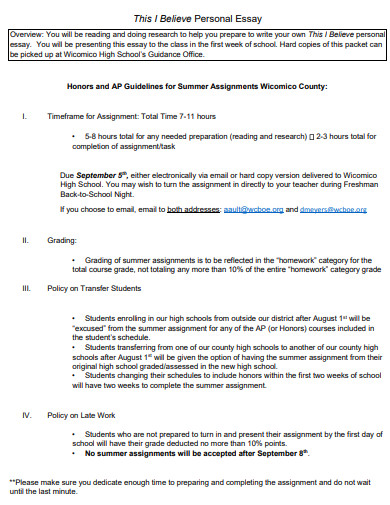
Size: 487 KB
2. Sample This I Believe Essay Example
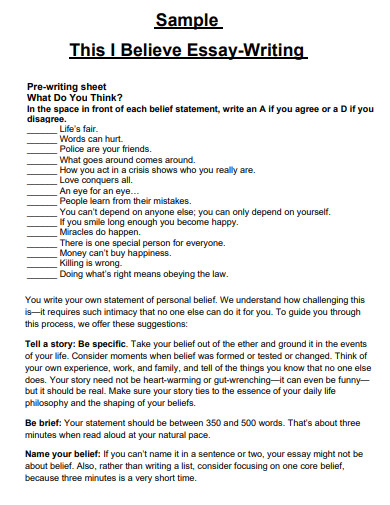
Size: 47 KB
3. Student This I Believe Essay Example
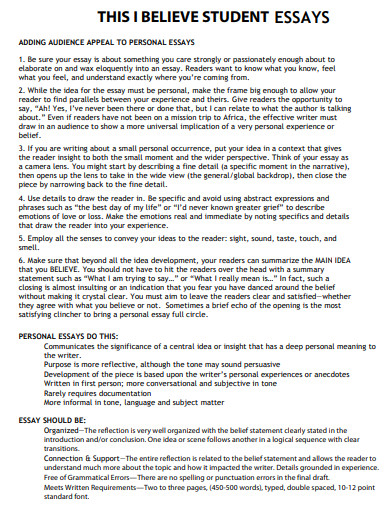
Size: 173 KB
4. Middle School This I Believe Essay Example

Size: 270 KB
5. This I Believe Essay Topic Example
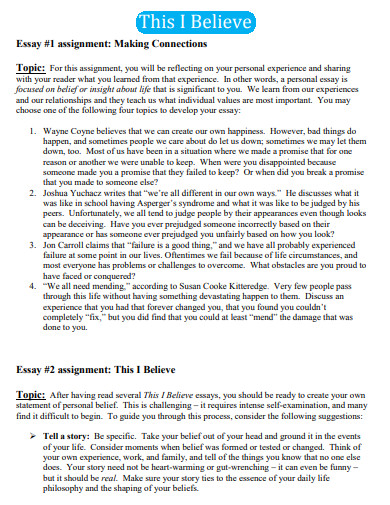
Size: 532 KB
6. This I Believe Essay Life Example

Size: 101 KB
7. This I Believe Essay Overview Example
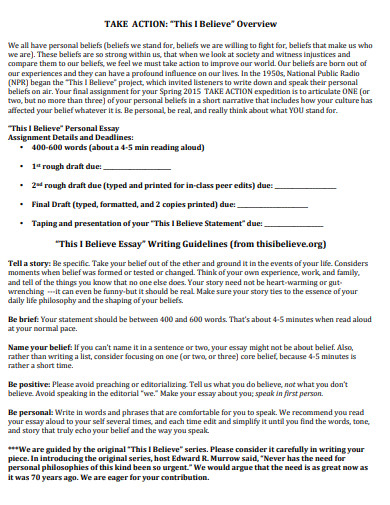
Size: 67 KB
8. This I Believe Essay Steps Example
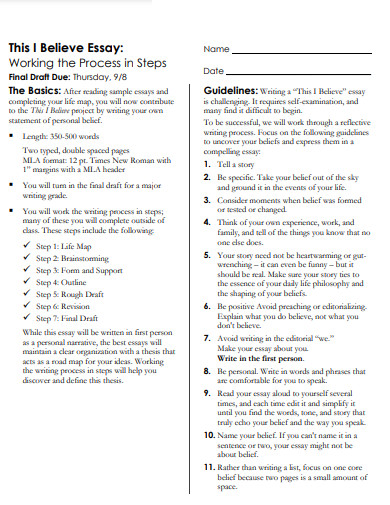
Size: 156 KB
9. This I Believe Essay Friendship Example
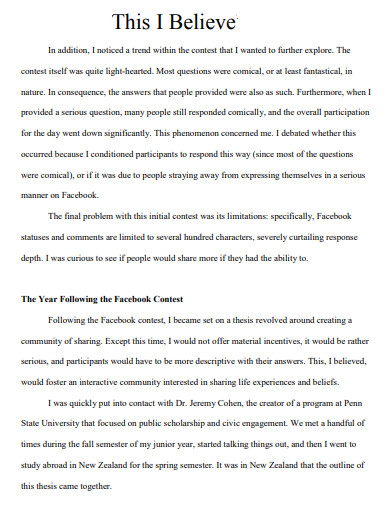
Size: 426 KB
10. Sports This I Believe Essay Example
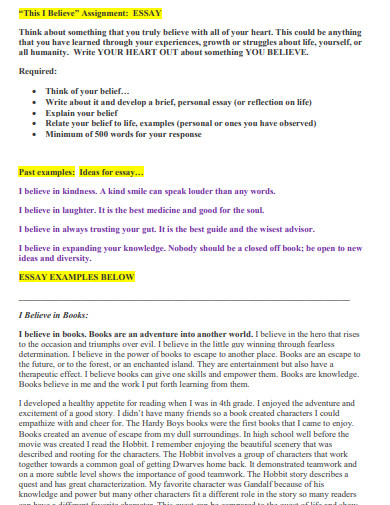
Size: 159 KB
11. This I Believe Essay Rubric Example
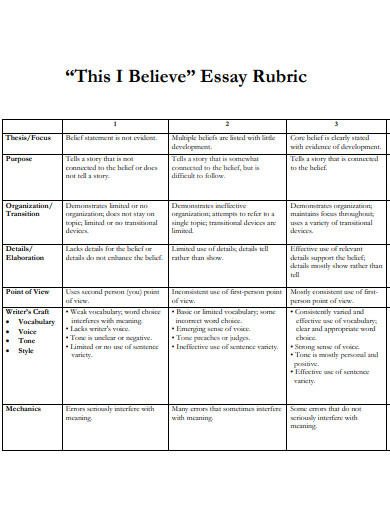
Size: 84 KB
12. This I Believe Personal Essay Example
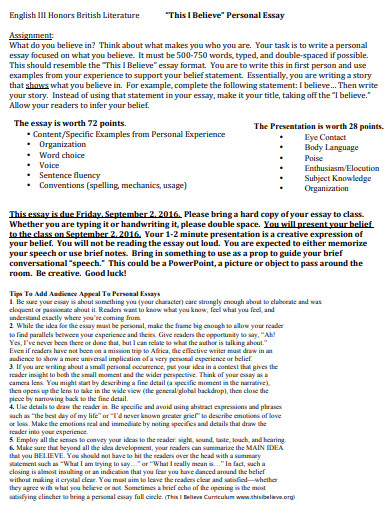
Size: 104 KB
13. This I Believe Essay Writing Example

Size: 175 KB
14. This I Believe Essay Statement Example
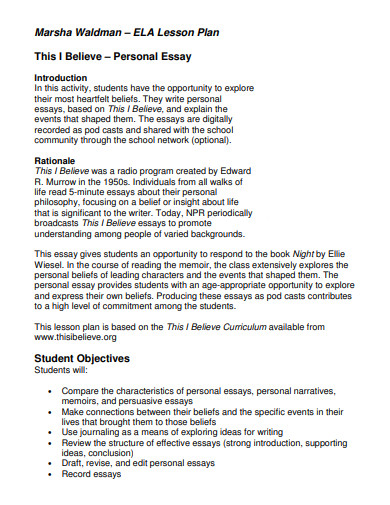
Size: 55 KB
15. God This I Believe Essay Example
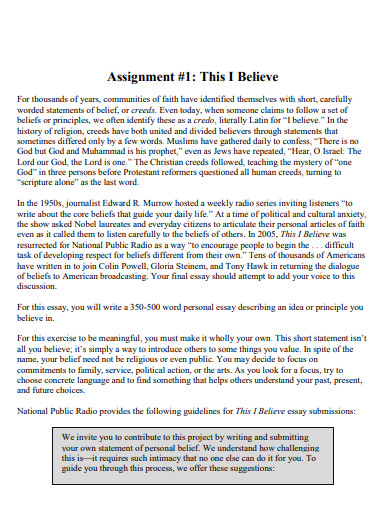
Size: 117 KB
16. This I Believe Essay Brief Example
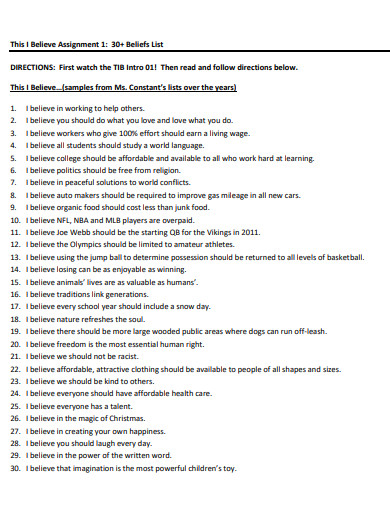
Size: 121 KB
17. This I Believe Essay Thesis Statement Example
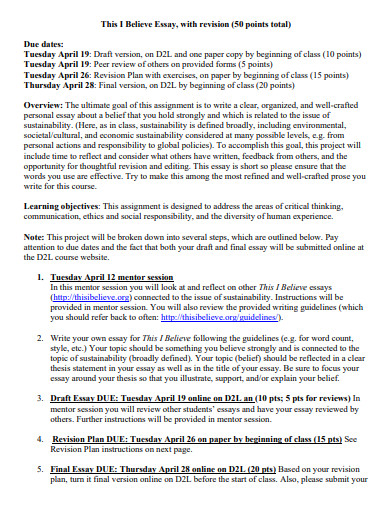
Size: 11 KB
18. This I Believe Essay Speech Example
19. this i believe essay college example.
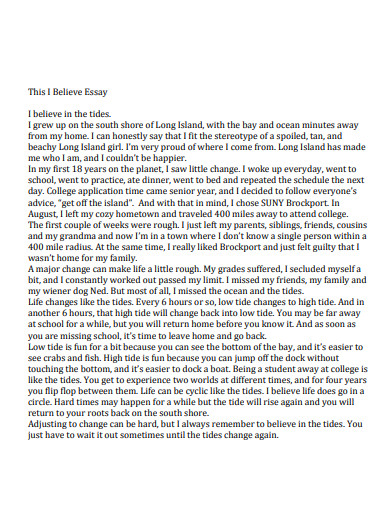
Size: 66 KB
20. This I Believe Essay Lesson Plan Example
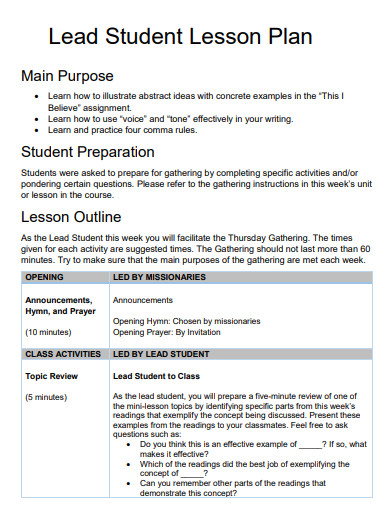
Size: 63 KB
21. This I Believe Essay Music Example
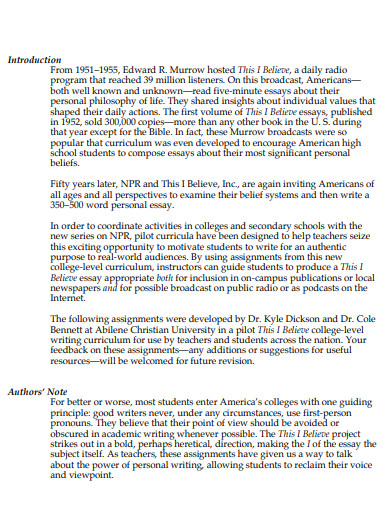
Size: 406 KB
22. Faith This I Believe Essay Example
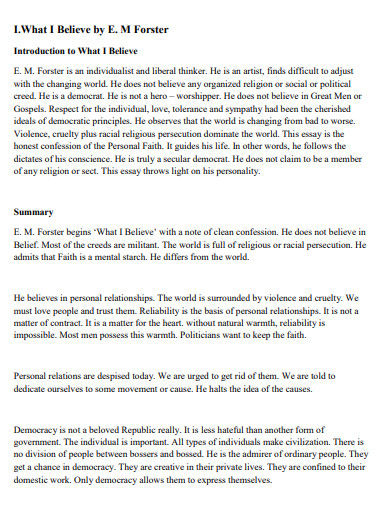
Size: 198 KB
23. Reflection This I Believe Essay Example

Size: 37 KB
24. This I Believe Immigration Essay Example
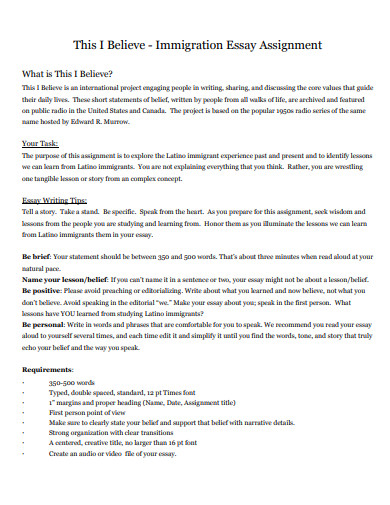
Size: 50 KB
25. This I Believe Love Essay Example
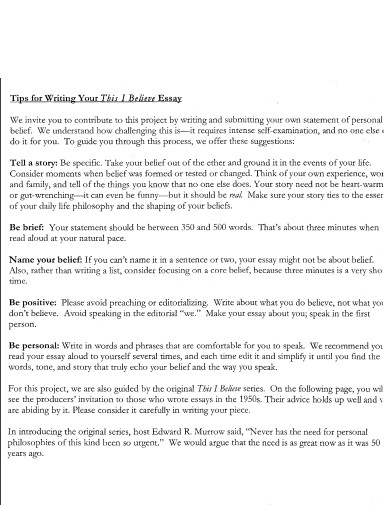
Size: 709 KB
26. This I Believe Dream Essay Example
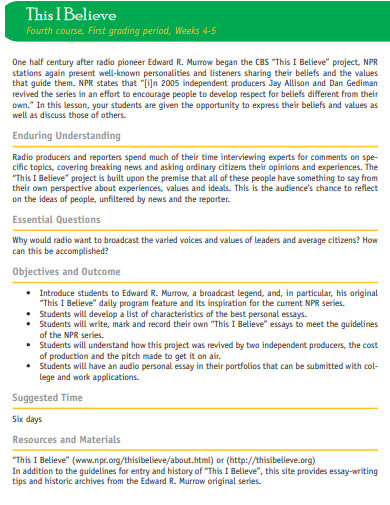
Size: 154 KB
27. This I Believe Power Essay Example
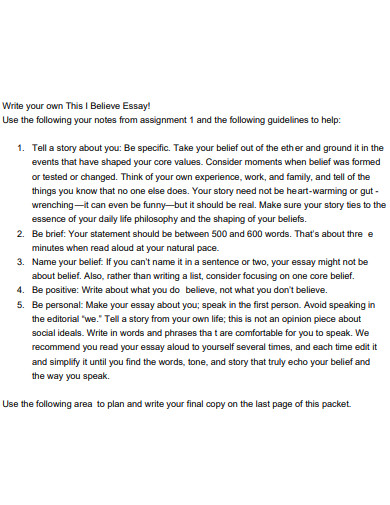
Size: 89 KB
28. This I Believe Essay Prompt Example
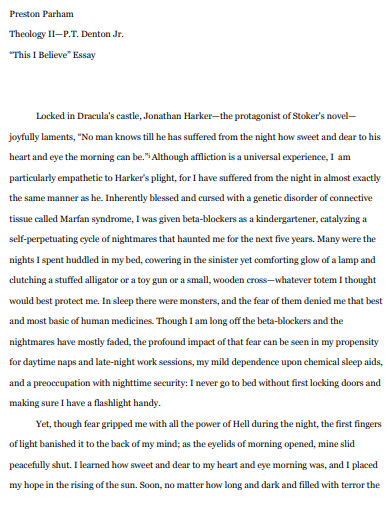
Size: 51 KB
29. This I Believe Essay Peer Review Example
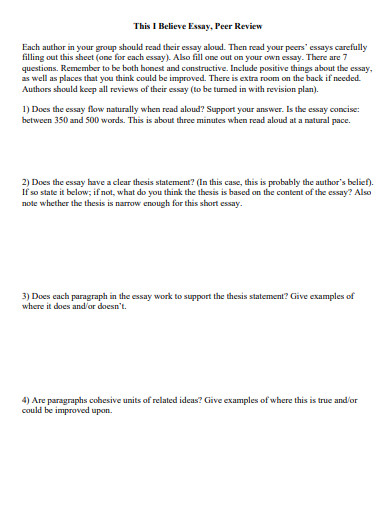
30. Elements of This I Believe Essay Example
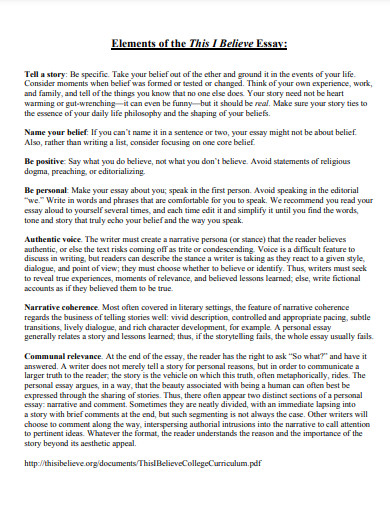
31. This I Believe Essay Transcript Example
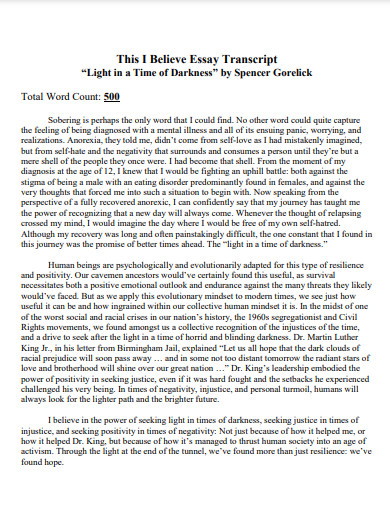
Size: 259 KB
What is a This I Believe Essay?
A This I Believe essay is a written composition that encapsulates an individual’s personal beliefs, values, and philosophies. Often reflective and intimate in nature, these essays offer readers insight into the author’s subjective understanding of the world. They provide an opportunity to explore the depth of one’s convictions, making use of various literary devices and characteristics to convey a sense of authenticity and sincerity. Through the exploration of individual experiences and convictions, these essays aim to connect with readers on a personal and emotional level.
How to Write a This I Believe Essay
Step 1: choose your core belief.
At the heart of your essay lies your core belief. Choose a belief that holds personal significance and represents your worldview. This belief should be something you feel passionately about and can articulate convincingly.
Step 2: Develop a Compelling Context
Create a context for your belief by providing background information. Explain why this belief is important to you and how it has shaped your experiences and outlook on life. A relatable context will engage your readers and make your essay more relatable.
Step 3: Employ Effective Literary Devices
Incorporate literary devices to enhance the impact of your essay. Metaphors, similes, and anecdotes can help convey your belief in a vivid and relatable manner. Consider how these devices can strengthen your narrative and connect with your audience emotionally.
Step 4: Craft a Strong Conclusion
Summarize your belief and its significance in your life, reinforcing the message you want to leave with your readers. Reflect on the journey you’ve taken them on and inspire them to reflect on their own beliefs.
Can I write about a commonly held belief?
Absolutely. While it’s important to maintain authenticity, even exploring a cliché belief can be powerful when you provide a fresh perspective or personal context. Your unique experiences and reflections make your essay stand out.
Can I use proper nouns in my essay?
Yes, proper nouns can add specificity and authenticity to your essay. Mentioning specific places, people, or events can help ground your beliefs in real-world experiences.
How can I make my essay more impactful?
Focus on using strong verbs to convey emotions and actions. Instead of saying “I felt sad,” consider saying “I crumbled under the weight of sorrow.” This adds depth to your writing and engages the reader’s senses.
In the realm of personal expression, the This I Believe essay shines as a vehicle for exploring one’s deepest convictions. By carefully selecting beliefs, weaving context, employing literary devices, and crafting strong conclusions, authors can create narratives that resonate with readers on a profound level. Through the power of words, these essays bridge the gap between individual experiences and universal truths, reminding us of the strength and diversity of human beliefs. So, take the plunge into introspection and share your beliefs with the world through the art of the This I Believe essay.
This I Believe Essay Generator
Text prompt
- Instructive
- Professional
Write a This I Believe Essay about the power of kindness in everyday life
Discuss in a This I Believe Essay how overcoming challenges has shaped your character
Ultimate Guide to Writing Your College Essay
Tips for writing an effective college essay.
College admissions essays are an important part of your college application and gives you the chance to show colleges and universities your character and experiences. This guide will give you tips to write an effective college essay.
Want free help with your college essay?
UPchieve connects you with knowledgeable and friendly college advisors—online, 24/7, and completely free. Get 1:1 help brainstorming topics, outlining your essay, revising a draft, or editing grammar.
Writing a strong college admissions essay
Learn about the elements of a solid admissions essay.
Avoiding common admissions essay mistakes
Learn some of the most common mistakes made on college essays
Brainstorming tips for your college essay
Stuck on what to write your college essay about? Here are some exercises to help you get started.
How formal should the tone of your college essay be?
Learn how formal your college essay should be and get tips on how to bring out your natural voice.
Taking your college essay to the next level
Hear an admissions expert discuss the appropriate level of depth necessary in your college essay.
Student Stories
Student Story: Admissions essay about a formative experience
Get the perspective of a current college student on how he approached the admissions essay.
Student Story: Admissions essay about personal identity
Get the perspective of a current college student on how she approached the admissions essay.
Student Story: Admissions essay about community impact
Student story: admissions essay about a past mistake, how to write a college application essay, tips for writing an effective application essay, sample college essay 1 with feedback, sample college essay 2 with feedback.
This content is licensed by Khan Academy and is available for free at www.khanacademy.org.
- Share full article
Advertisement
Supported by
Guest Essay
Elite College Admissions Have Turned Students Into Brands

By Sarah Bernstein
Ms. Bernstein is a playwright, a writing coach and an essayist in Brooklyn.
“I just can’t think of anything,” my student said.
After 10 years of teaching college essay writing, I was familiar with this reply. For some reason, when you’re asked to recount an important experience from your life, it is common to forget everything that has ever happened to you. It’s a long-form version of the anxiety that takes hold at a corporate retreat when you’re invited to say “one interesting thing about yourself,” and you suddenly believe that you are the most boring person in the entire world. Once during a version of this icebreaker, a man volunteered that he had only one kidney, and I remember feeling incredibly jealous of him.
I tried to jog this student’s memory. What about his love of music? Or his experience learning English? Or that time on a summer camping trip when he and his friends had nearly drowned? “I don’t know,” he said with a sigh. “That all seems kind of cliché.”
Applying to college has always been about standing out. When I teach college essay workshops and coach applicants one on one, I see my role as helping students to capture their voice and their way of processing the world, things that are, by definition, unique to each individual. Still, many of my students (and their parents) worry that as getting into college becomes increasingly competitive, this won’t be enough to set them apart.
Their anxiety is understandable. On Thursday, in a tradition known as “Ivy Day,” all eight Ivy League schools released their regular admission decisions. Top colleges often issue statements about how impressive (and competitive) their applicant pools were this cycle. The intention is to flatter accepted students and assuage rejected ones, but for those who have not yet applied to college, these statements reinforce the fear that there is an ever-expanding cohort of applicants with straight A’s and perfect SATs and harrowing camping trip stories all competing with one another for a vanishingly small number of spots.
This scarcity has led to a boom in the college consulting industry, now estimated to be a $2.9 billion business. In recent years, many of these advisers and companies have begun to promote the idea of personal branding — a way for teenagers to distinguish themselves by becoming as clear and memorable as a good tagline.
While this approach often leads to a strong application, students who brand themselves too early or too definitively risk missing out on the kind of exploration that will prepare them for adult life.
Like a corporate brand, the personal brand is meant to distill everything you stand for (honesty, integrity, high quality, low prices) into a cohesive identity that can be grasped at a glance. On its website, a college prep and advising company called Dallas Admissions explains the benefits of branding this way: “Each person is complex, yet admissions officers only have a small amount of time to spend learning about each prospective student. The smart student boils down key aspects of himself or herself into their personal ‘brand’ and sells that to the college admissions officer.”
Identifying the key aspects of yourself may seem like a lifelong project, but unfortunately, college applicants don’t have that kind of time. Online, there are dozens of lesson plans and seminars promising to walk students through the process of branding themselves in five to 10 easy steps. The majority begin with questions I would have found panic-inducing as a teenager, such as, “What is the story you want people to tell about you when you’re not in the room?”
Where I hoped others would describe me as “normal” or, in my wildest dreams, “cool,” today’s teenagers are expected to leave this exercise with labels like, Committed Athlete and Compassionate Leader or Environmentally Conscious Musician. Once students have a draft of their ideal self, they’re offered instructions for manifesting it (or at least, the appearance of it) in person and online. These range from common-sense tips (not posting illegal activity on social media) to more drastic recommendations (getting different friends).
It’s not just that these courses cut corners on self-discovery; it’s that they get the process backward. A personal brand is effective only if you can support it with action, so instead of finding their passion and values through experience, students are encouraged to select a passion as early as possible and then rack up the experience to substantiate it. Many college consultants suggest beginning to align your activities with your college ambitions by ninth grade, while the National Institute of Certified College Planners recommends students “talk with parents, guardians, and/or an academic adviser to create a clear plan for your education and career-related goals” in junior high.
The idea of a group of middle schoolers soberly mapping out their careers is both comical and depressing, but when I read student essays today, I can see that this advice is getting through. Over the past few years, I have been struck by how many high school seniors already have defined career goals as well as a C.V. of relevant extracurriculars to go with them. This widens the gap between wealthy students and those who lack the resources to secure a fancy research gig or start their own small business. (A shocking number of college applicants claim to have started a small business.) It also puts pressure on all students to define themselves at a moment when they are anxious to fit in and yet changing all the time.
In the world of branding, a word that appears again and again is “consistency.” If you are Charmin, that makes sense. People opening a roll of toilet paper do not want to be surprised. If you are a teenage human being, however, that is an unreasonable expectation. Changing one’s interests, opinions and presentation is a natural part of adolescence and an instructive one. I find that my students with scattershot résumés are often the most confident. They’re not afraid to push back against suggestions that ring false and will insist on revising their essay until it actually “feels like me.” On the other hand, many of my most accomplished students are so quick to accept feedback that I am wary of offering it, lest I become one more adult trying to shape them into an admission-worthy ideal.
I understand that for parents, prioritizing exploration can feel like a risky bet. Self-insight is hard to quantify and to communicate in a college application. When it comes to building a life, however, this kind of knowledge has more value than any accolade, and it cannot be generated through a brainstorming exercise in a six-step personal branding course online. To equip kids for the world, we need to provide them not just with opportunities for achievement, but with opportunities to fail, to learn, to wander and to change their minds.
In some ways, the college essay is a microcosm of modern adolescence. Depending on how you look at it, it’s either a forum for self-discovery or a high-stakes test you need to ace. I try to assure my students that it is the former. I tell them that it’s a chance to take stock of everything you’ve experienced and learned over the past 18 years and everything you have to offer as a result.
That can be a profound process. But to embark on it, students have to believe that colleges really want to see the person behind the brand. And they have to have the chance to know who that person is.
Sarah Bernstein is a playwright, a writing coach and an essayist.
The Times is committed to publishing a diversity of letters to the editor. We’d like to hear what you think about this or any of our articles. Here are some tips . And here’s our email: [email protected] .
Follow the New York Times Opinion section on Facebook , Instagram , TikTok , WhatsApp , X and Threads .

IMAGES
VIDEO
COMMENTS
Explore. Featured Essays Essays on the Radio; Special Features; 1950s Essays Essays From the 1950s Series; Browse by Theme Browse Essays By Theme Use this feature to browse through the tens of thousands of essays that have been submitted to This I Believe. Select a theme to see a listing of essays that address the selected theme. The number to the right of each theme indicates how many essays ...
To better train students on how to present their personal opinions on subjective matters, teachers will assign what is known as an "I Believe" or "This I Believe" essay writing assignment. Designed to provide the reader with insight into the writer's character, these essays are typically written in first-person point of view. The writer shares …
Reading a collection of This I Believe essays: • encourages students to read beyond textbooks. • enriches the campus community through exploration of personal values and beliefs. • raises awareness and tolerance of intergenerational and cultural likenesses and differences. • promotes civic discourse and critical thinking. • increases ...
Out of many, seven This I Believe essays stood out to a reading committee made up of students, faculty, and staff. This I Believe is a popular essay genre that allows the writer to share a personal belief and, through a narrative, explain that belief's origin or a time that belief was put into action. The essay genre started in the 1950s on a ...
From a student battling depression and anxiety. From a student who missed almost a whole semester but is trying to stay in school. Although this essay helped end the year with a strong sense of community, I think teachers could easily have students write it at the beginning of the school year or even in January at the start of a new year.
This I Believe is an exciting media project that invites individuals from all walks of life to write about and discuss the core beliefs that guide their daily lives. They share these statements in weekly broadcasts on NPR's Morning Edition and All Things Considered. The series is based on the 1950's radio program This I Believe, hosted by ...
I Believe has featured essays by prominent Americans such as Colin Powell, Gloria Steinem, Bill Gates, Robert Fulghum, and Yo-Yo Ma, as well as those of everyday citizens, including students, artists, scientists, writers, politicians, and even an astronaut. A forum for thoughtful discourse The This I Believe essay-writing
Here's the prompt I used: This I Believe. For 2 minutes: List words or ideas that you think about when you think of YOUR LIFE. (Can be feelings, symbols, names, events, etc.) After students generated this list, I asked them to consider what they wanted to write about and share with others.
Presented in five consecutive standard-period classes, students are invited to contribute to the This I Believe essay-writing project by writing and submitting a statement of personal belief. This is a challenging, intimate statement on one's beliefs and one's own daily life philosophy, considering moments when belief was formed, tested, or ...
This I Believe Beginning in 1951, radio pioneer Edward R. Murrow asked Americans from all walks of life to write essays about their most fundamental and closely held beliefs. Half a century later ...
Writing Assignment Description. Tenth-grade students at the Springfield Renaissance School in Springfield, Massachusetts, as part of their English Language Arts class, created This I Believe essays. The format for This I Believe essays has a long heritage, beginning with a radio program in the 1950's with that name, hosted by journalist ...
3 Ways This I Believe Essays Support Writing Instruction by Deanna Mascle Originally published 5 March, 2020 ... TIB essays are good models for students. As noted above, they are short, focused arguments with no extraneous information which makes them great to study. Also, they weave in personal stories and details to support their argument ...
Once you have spent several days thinking and talking about beliefs as well as building community, share the This I Believe essay guidelines with your students and let them begin drafting final essays. Prepping for the Performance Event. Along the way, students can choose a committee to join to help prepare for the final performance event. ...
students have an opportunity to turn their essay into a digital story to demonstrate speaking and presentation skills. These will be shared with the entire class in a viewing celebration. To begin, follow the steps below: Step One: Get Familiar with the format. Explore historical and modern This I Believe essays as "mentor texts." Notice
As always, maintain good spelling, grammar, punctuation and sentence structure. 1. Three choice words: List three choice words that you believe in—and explain from experience why these words came to mind. These words can make up a statement, a phrase or simply be three words that are important to you.
5. Students should explore the This I Believe essays linked in the resources. Teacher could assign these in small groups, do a jigsaw, do one together and then allow students to choose a second, etc. As students explore these essays, they should identify the core belief in each This I Believe essay and the story or the narrative behind it. 6.
This I Believe Essay Writing Suggestions. Power Lesson: "This I Believe" Essays. In this power lesson shared by high school English teacher Cynthia Ruiz, students write their own personal statements of belief. The essay pushes students to write about something that matters to them and helps them get to know each other on a deeper level.
of the essay. 4. Include a full, single-spaced heading, which is the stack of information on the top right of the page. Please include all of these items: Your name, language arts period, and date ----- Your Name L.A. Period Date This I Believe Essay Your Title Looks Like This Your essay should use this format.
Step 2: Develop a Compelling Context. Create a context for your belief by providing background information. Explain why this belief is important to you and how it has shaped your experiences and outlook on life. A relatable context will engage your readers and make your essay more relatable.
Sample College Essay 2 with Feedback. This content is licensed by Khan Academy and is available for free at www.khanacademy.org. College essays are an important part of your college application and give you the chance to show colleges and universities your personality. This guide will give you tips on how to write an effective college essay.
Ms. Bernstein is a playwright, a writing coach and an essayist in Brooklyn. "I just can't think of anything," my student said. After 10 years of teaching college essay writing, I was ...
STEM (Science, Engineering, Technology and Math) students at Mt. SAC have a golden opportunity. The college received a five-year, $1 million grant from the National Science Foundation's (NSF) Advanced Technological Equation Program (ATE), and Mt. SAC plans to support 80 students through the first four years of the project. So far in the first three years, 54 students have been assisted in ...